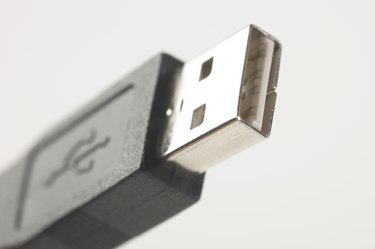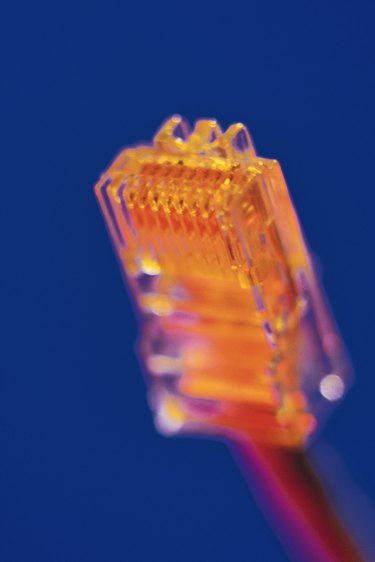
An Ethernet port connects a computer to a network and a USB port connects a computer to peripheral equipment such as a mouse or printer. To change a port from one to the other, you need an electronic adapter often called an Ethernet-to-USB cable. You can't splice the connections together using a pinout diagram.
USB-to-Ethernet Adapter
Video of the Day

Because USB and Ethernet signals differ, the two cannot be connected together without electronic processing. Many USB-to-Ethernet adapters plug directly into a USB port with a Ethernet connector on the other end, making them susceptible to physical damage. Some manufacturers add a short section of cable to relieve the potential pressure against the USB port on the computer, with the electronic components installed in the part that contains the Ethernet port. The wires do not make direct connections from the USB port to the Ethernet port.
Video of the Day
Adapter Applications
If your computer has a USB port but no Ethernet card installed, use a USB-to-Ethernet adapter instead. A USB cable can only carry a signal for up to 16 feet. If you have a peripheral device such as a printer at a longer distance, use USB adapters at the computer and printer and connect them together with an Ethernet cable up to 300 feet in length. Plug a USB-to-Ethernet adapter into a computer connected to a network to provide an additional Ethernet connection to the network.
USB Pinout
An A type USB connector has four pins arranged inside a small rectangular body. Pin 1 carries +5 volts to power peripheral devices such as USB-to-Ethernet adapters and webcams. Pin 2 carries received data labeled "Data-" and pin 3 carries transmit data called "Data+." Pin 4 carries the ground return for the other three connections. Although most USB connections use the A type, alternate mini A, B and mini B connectors are used on smaller peripheral devices such as digital cameras. The mini versions have five pins but the extra pin makes no connection.
Ethernet Pinout
An Ethernet connection uses an RJ45 plug with eight pins. Pins 1 and 2 carry transmit data and pins 5 and 6 carry receive data in a balanced configuration that isolates the signals from ground. For an Ethernet connection, the other four pins make no connection. An Ethernet port does not provide an external voltage for peripheral equipment. Most Ethernet connections use Category 5, also known as Cat5, cable without a shield, but other variations are available. Cat5 cable can carry all speeds of Ethernet at 10 Mbps, 100 Mbps or 1 Gbps.